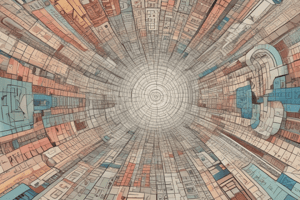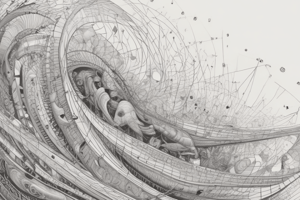Podcast
Questions and Answers
A medium-format camera--one that uses film larger than 35mm--the twin-lens reflex was immensely popular after World War II.
A medium-format camera--one that uses film larger than 35mm--the twin-lens reflex was immensely popular after World War II.
- Twin-Lens Reflex Cameras (correct)
- Single-Lens Reflex Cameras
- Multiple-Lens Reflex Cameras
Commonly refers to a point-and-shoot camera.
Commonly refers to a point-and-shoot camera.
- Point and Shoot camera
- Miniature Camera
- Instamatic Camera (correct)
Controls the duration of an exposure
Controls the duration of an exposure
- SHUTTER SPEED (correct)
- APERTURE
- SHUTTER
The place in a camera where the film is located in readiness for it to be exposed to light.
The place in a camera where the film is located in readiness for it to be exposed to light.
A lens with the ability to focus from infinity to extremely closely, allowing it to capture images of tiny objects in frame-filling, larger-than-life sizes
A lens with the ability to focus from infinity to extremely closely, allowing it to capture images of tiny objects in frame-filling, larger-than-life sizes
In time exposure photography, an object that is only partially recorded on the film and therefore has a translucent, ghost-like appearance.
In time exposure photography, an object that is only partially recorded on the film and therefore has a translucent, ghost-like appearance.
A darkroom device used to hold paper flat while exposing it to light from an enlarger.
A darkroom device used to hold paper flat while exposing it to light from an enlarger.
occurs when an area that is smaller than the entire image frame is printed or reproduced.
occurs when an area that is smaller than the entire image frame is printed or reproduced.
Also known as "Printing in." In a darkroom, providing extra exposure to an area of the print to make it darker, while blocking light from the rest of the print.
Also known as "Printing in." In a darkroom, providing extra exposure to an area of the print to make it darker, while blocking light from the rest of the print.
usually called Photo-Flo, is a chemical designed to reduce the surface tension of water, thus reducing the possibility of water spots forming on film as it dries.
usually called Photo-Flo, is a chemical designed to reduce the surface tension of water, thus reducing the possibility of water spots forming on film as it dries.
Flashcards are hidden until you start studying
Study Notes
Camera Types and Functions
- A medium-format camera uses film larger than 35mm and was popular after World War II, with one type being the twin-lens reflex.
- A point-and-shoot camera is commonly referred to as a type of camera.
Camera Components
- The camera has a specific place where the film is located in readiness for exposure to light.
Lenses
- A lens with the ability to focus from infinity to extremely closely is capable of capturing images of tiny objects in frame-filling, larger-than-life sizes.
Photography Techniques
- Time exposure photography can result in an object being only partially recorded on the film, giving it a translucent, ghost-like appearance.
- In printing, "printing in" or "burning in" occurs when an area of the print is given extra exposure to make it darker, while blocking light from the rest of the print.
Darkroom Equipment and Chemicals
- A darkroom device is used to hold paper flat while exposing it to light from an enlarger.
- Photo-Flo is a chemical that reduces the surface tension of water, reducing the possibility of water spots forming on film as it dries.
Studying That Suits You
Use AI to generate personalized quizzes and flashcards to suit your learning preferences.



